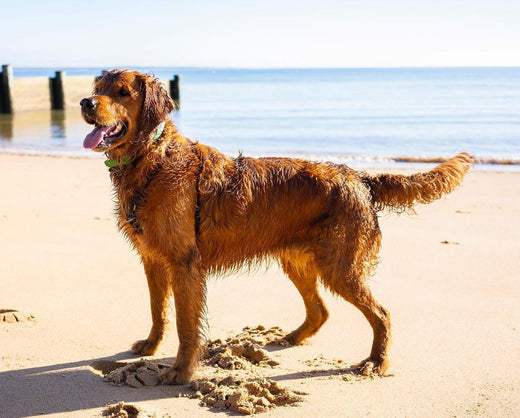Master Your Pup’s Fur Care Routine
Your dog’s fur has it tough. Between your loving pats and cuddles, your pup’s coat has to contend with grass rolls, sandy beach excursions, sweaty hot walks, and everything else your little mischief-maker gets up to. This brings us to the golden question: How often should you wash your dog?
The Goldilocks Zone of Dog Washing
Washing your dog is a balance between doing too much fur care and not enough. Like human hair, overwashing your dog’s coat will disrupt its natural oil production, resulting in dry and wiry fur. Think bad hair day—every day.
Signs That Your Dog Is Being Washed Too Often
- Dry and brittle fur
- Fur is losing its lustre and looks dull
- Red, irritated skin or rashes due to overuse of shampoo and other chemicals
- Increased fur loss due to a weaker, damaged coat
On the other hand, not washing your dog enough can lead to even worse issues! Not washing your pooch regularly or as needed will lead to greasy, matted fur, increased parasite and pest risk, behavioural changes, and a seriously smelly dog.
Signs That Your Dog Isn’t Being Washed Enough
- Dirty-looking coat
- Greasy fur
- Smelly coat
- Their fur mats more easily (even with regular brushing)
Your dog’s hygiene is essential to keeping a clean house, especially if your pup hangs around babies, toddlers, or small children whose immune systems are vulnerable and still developing.

Credit: @cuddlemecairo
How Often Should You Wash Your Dog?
Your dog’s personalised fur care routine largely depends on your answer to two questions: (1) What is your dog’s breed? (2) What is your dog’s lifestyle?
1. What is Your Dog’s Breed?
Your dog’s breed and fur type are the biggest factors in how often they should be washed. Here’s our quick guide to dog breeds and fur types that need more regular or less frequent washes:
More Frequent Washes (4-6 weeks)
- Thick, dense coats that trap dirt and oil. E.g. golden retrievers, huskies, border collies.
- Curly coats that easily tangle and knot. E.g. poodles, doodle breeds, lagottos.
- Short fur with skin folds that accumulate dirt. E.g. pugs, bulldogs, French bulldogs.
Less Frequent Washes (6-8 weeks)
- Very short and smooth coats that require low maintenance. E.g. whippets, greyhounds, beagles, dachshunds.
- Oily and wiry coats that naturally repel dirt. E.g. schnauzers, fox terriers.
2. What is Your Dog’s Lifestyle?
We recommend using your dog’s breed and fur type as the basis for your fur care regime, but be sure to adapt it to your pooch’s lifestyle. Here are our top reasons for whipping out the doggie shampoo early:
- When they get muddy (beyond what a dog wipe can fix)
- After trips to the beach (when a towel and rub-down aren’t enough to clean them)
- When they smell sweaty after a long, hot run
- For parasite or pest control
- When they roll in something unsavoury
Tip: Remember to use only dog-safe products, not human shampoos! Products designed for humans can have chemicals that are too harsh for dogs’ eyes, fur, and skin.

Credit: @martin.the.iggy
Our Best Dog Washing Routine
- Brush
Every dog wash should begin with a thorough brush. If your pup starts their wash with knots and tangles, they’re only going to get worse! So, work out that matted fur before your buddy gets wet. You might need to break out the detangler spray for curlier fur.
- Wet
Once your pup is fully brushed, take them to the shower/bath/puppy pool to wet their fur. Use warm or cold water, depending on the temperature, and ensure that their coat is thoroughly wet (even that undercoat!). Be careful of water around their eyes, ears, and nose.
- Shampoo
Now for the shampoo massage! Lather up your pup and really work the shampoo into the roots in a circular motion for a deep clean. This is your chance to show your buddy what a wonderful thing wash time is!
- Rinse
Rinse away the shampoo, working your fingers through the fur to ensure no shampoo remains. It’s important that no products are left in the coat, as this can make it look greasy and clumped when dry. If your pup has a high-maintenance coat, now’s the time to use a leave-in conditioner or detangler spray.
Tip: Don’t forget to wipe down your dog’s collar and lead at the same time!
- Rub Down & Dry
Towel time! If you can, get your dog to shake and then rub them down with a dry, clean towel. You’ll never be able to dry their coat completely, so either let them air dry, use a hairdryer on a safe heat setting, or take them for a walk in the sun if it’s warm enough.
- Brush
Chances are, your pup has a whole new set of tangles after their wash and rub-down. Give them a thorough brush to complete your dog’s pamper sesh.
Tip: Use treats throughout your dog’s routine to teach them that wash time is fun and positive. Not something to be scared of! Stay calm, take it slow, and reassure your pup every step of the way if they’re new to the wash experience.
You Are the Best Judge
We can offer loads of advice on how often you should wash your dog, but your judgment will be the best guide. Feel your bestie’s fur, smell it, wipe it with a clean dog wipe, and you’ll know straight away if they’re due for their next shampoo.

Credit: @stinkybubur

